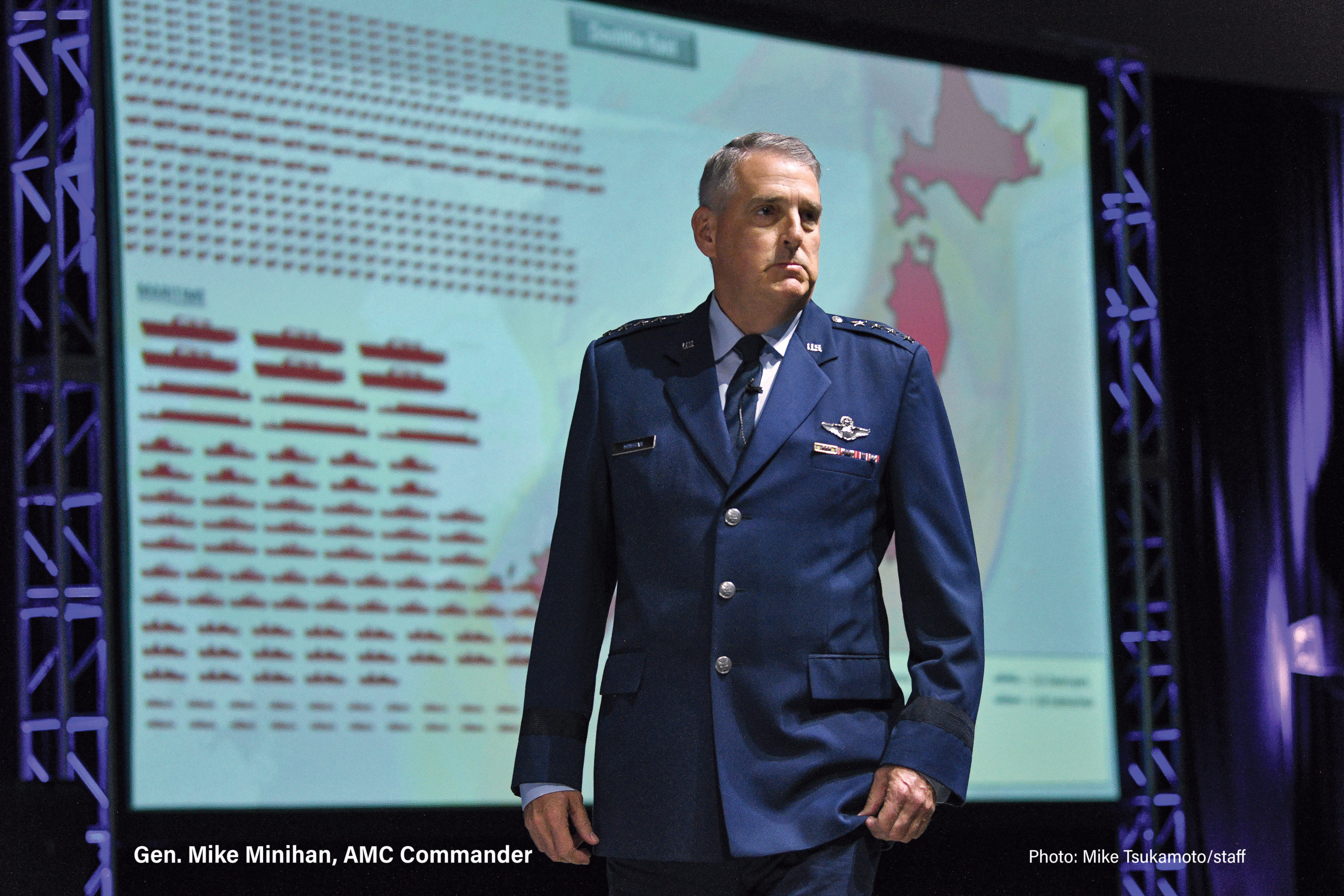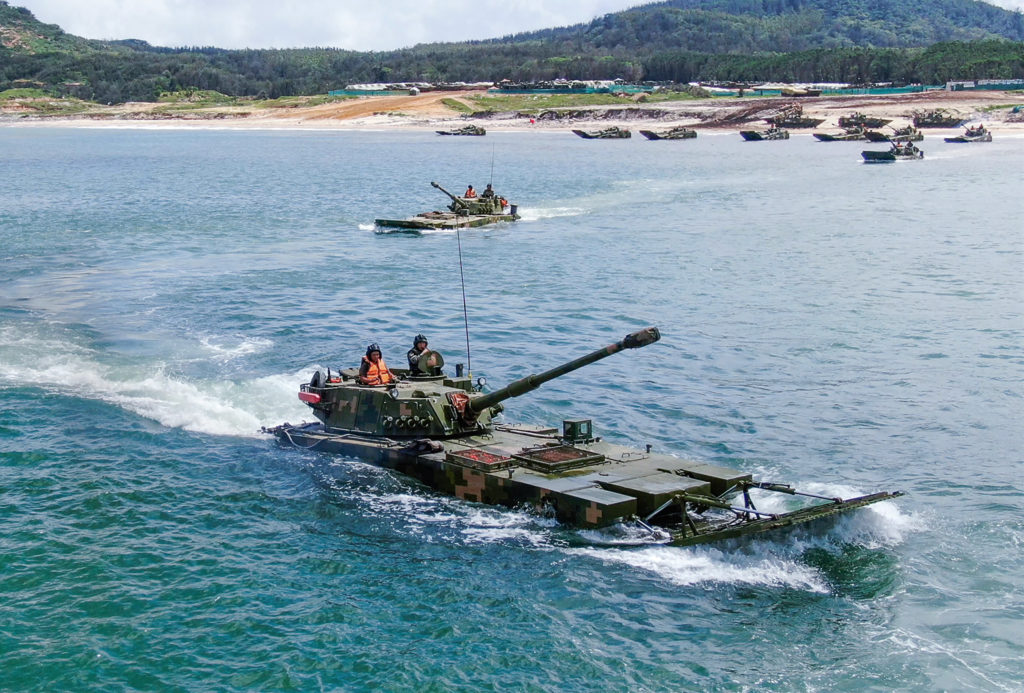USAF Bursts Chinese Surveillance Balloon, as Nation Comes to Grips With an Ever-More Assertive People’s Republic.
Military leaders and some politicians have been talking up the threat posed by China with increasing alarm in recent months, but for many Americans that concern didn’t fully hit home until a Chinese surveillance balloon drifted into the public consciousness Feb. 2. The balloon caused aviation officials in Billings, Mont., to shut down air operations at the airport there for hours and prompted consternation among citizens and public officials alike over such an overt violation of public airspace.
We successfully took it down, and I want to compliment our aviators who did it.President Joe Biden
Air Force jets scrambled to respond, but U.S. officials did not shoot the balloon down until it moved over water. At 2:39 p.m. on Feb. 4, a pair of F-22s from the 1st Fighter Wing at Joint Base Langley-Eustis, Va., approached the balloon off the coast of South Carolina, and fired a single AIM-9X Sidewinder missile into the approximately 90-foot-wide balloon, sending it plunging into the Atlantic Ocean below.
“We successfully took it down, and I want to compliment our aviators who did it,” said President Joe Biden.
The incident played out in the midst of a national debate over U.S. relations with China and the relative risk of war, sparked first by a memo from Air Mobility Command boss Gen. Mike A. Minihan to his Airmen in which he warned of his “gut” feeling that conflict could break out with China within the next two years.
“I hope I am wrong,” Minihan wrote, but “my gut tells me we will fight in 2025. [Chinese President Xi Jinping] secured his third term and set his war council in October 2022. Taiwan’s presidential elections are in 2024 and will offer Xi a reason. United States’ presidential elections are in 2024 and will offer Xi a distracted America. Xi’s team, reason, and opportunity are all aligned for 2025.”
The memo, sent to AMC wing commanders and other leaders in the command, was soon leaked to the media, where its candor sparked debate among those who thought it saber-rattling and others who saw it as straight talk from a plain-speaking commander.
Former National Security Adviser Robert C. O’Brien was among those praising Minihan, writing on Twitter that Minihan’s memo “demonstrates solidarity with the men & women he leads by telling them the truth that all of us at the senior level know, but few are willing to utter. He should be commended.”
Retired Lt. Gen. David A. Deptula, dean of AFA’s Mitchell Institute for Aerospace Studies, praised Minihan in a LinkedIn post, saying he “should be commended for the clarity in which he delivers his messages, sense of urgency, and speaking as a warfighter—not a bureaucrat, politico, or academic.”
In an interview with Air & Space Forces Magazine, Deptula called Minihan’s memo “wholly appropriate,” and a necessary reminder for AMC Airmen, who are responsible for all the Air Force’s cargo and refueling missions.
“Air Mobility Command is a combat-oriented command,” Deptula said. “Its day-to-day airlift missions often appear more like a commercial airline mission than an organization in the thick of flying and fighting. But the point that Minahan was making is the violence of combat comes quickly. And he wants his crews to be thinking about that and ready to support delivering devastating consequences to the enemy in a very hostile environment.”
Minihan was rightly “trying to instill this perspective on his Airmen, that they need to be thinking about what’s necessary to succeed in combat against our pacing threat and raise that awareness that it’s not business as usual in that this possibility could come sooner rather than later.”
Minihan and China: In His Own Words
This message from Air Mobility Command boss Gen. Mike Minihan to his Airmen generated international headlines and sparked debate among lawmakers, experts, and observers. Here is the memo in full, with additional context in brackets.
DEPARTMENT OF THE AIR FORCE
HEADQUARTERS AIR MOBILITY COMMAND
MEMORANDUM FOR 18 AF/CC, EC/CC, 22 AF/CC, 4 AF/CC, 618 AOC/CC, ALL AMC WING COMMANDERS
FROM: AMC/CC
1 February 2023
SUBJECT: February 2023 Orders in Preparation for—
The Next Fight
SITUATION. I hope I am wrong. My gut tells me we will fight in 2025. [Chinese President Xi Jinping] secured his third term and set his war council in October 2022. Taiwan’s presidential elections are in 2024 and will offer Xi a reason. United States’ presidential elections are in 2024 and will offer Xi a distracted America. Xi’s team, reason, and opportunity are all aligned for 2025. We spent 2022 setting the foundation for victory. We will spend 2023 in crisp operational motion building on that foundation. If you want to know what the operational motion I demand looks like, look at what Total Force Team Charleston did in January.
COMMANDER’S INTENT. Go faster. Drive readiness, integration, and agility for ourselves and the Joint Force to deter, and if required, defeat China. This is the first of 8 monthly directives from me. You need to know I alone own the pen on these orders. My expectations are high, and these orders are not up for negotiation. Follow them. I will be tough, fair, and loving in my approach to secure victory.
END STATE. A fortified, ready, integrated, and agile Joint Force Maneuver Team ready to fight and win inside the first island chain. Maximize the use of the force and the tools we currently have and extract full value from things that currently exist. Close the gaps: C2, navigation, maneuver under attack, and tempo.
RISK. Run deliberately, not recklessly. You will be governed by the principle of calculated training risk, which you shall interpret to mean the avoidance of death, serious injury, and Class A damage to attain higher readiness, integration, and agility. If the Tactic, Technique, and Procedure you are developing increases AMC’s ability to fight and win inside the first island chain … move out. If you are comfortable in your approach to training, then you are not taking enough risk.
OT&E. Attached are our OT&E efforts from 2022 Fall PHOENIX Rally, which will guide our preparation but are not intended to limit creativity of approach. This is not an all-encompassing list. I expect you to move out briskly on the monthly tasks, anticipate the projected tasks and weave them eloquently into your units’ training and operational battle rhythms.
FEBRUARY.
(a) All AMC aligned personnel with weapons qualifications will fire a clip into a 7-meter target with the full understanding that unrepentant lethality matters most. Aim for the head.
(b) All AMC personnel will update vRED [virtual Record of Emergency Data].
(c) All commanders will acknowledge this order directly to me immediately. Then, report all 2022 accomplishments preparing for the China fight, and forecast major efforts in 2023 through command chains by COB 28 February 2023.
MARCH (Projected).
(a) All units will report progress toward established OT&E requirements for INDOPACOM Operations discussed and reviewed at Fall PHOENIX Rally.
(b) All AMC personnel will consider their personal affairs and whether a visit should be scheduled with their servicing base legal office to ensure they are legally ready and prepared.
(c) KC-135 units will coordinate to provide a conceptual means of air delivering 100 off-the-shelf size and type UAVs from a single aircraft.
APRIL (Projected).
(a) All units will report their integration and operation plans for MOBILITY GUARDIAN 2023 to include all events (lead-in and concurrent) they wish to include for credit.
ADMIN. AMC/A3 [Operations] will formalize these orders in FRAGO [Fragmentary Order] format. Completion, progress, reporting, reporting format, and advancement be measured, driven, and collected by our AMC/A3 Team through ARC [Air Reserve Command], NAF [Numbered Air Force] and EC [Expeditionary Center] leadership.
LET’S GO!
MICHAEL A. MINIHAN
General, USAF
Commander
China Worries
Air Force Secretary Frank Kendall has repeatedly cited his concerns about China as his motivation for returning to public service when others might be retired in order to apply decades of Cold War experience to the rising challenge in the east. Ensuring technological superiority over China is the primary driver, in fact, for Kendall’s seven operational imperatives, which have framed his priorities as the Air Force’s top civilian since he defined them at the AFA Warfare Symposium a year ago.
Warnings about Chinese behavior and aggression have likewise been sounded by seeking out his job following President Biden’s election to the presidency in 2020. The Navy’s Chief of Naval Operations Adm. Michael M. Gilday, who said in October the U.S. should prepare to fight in 2022 or 2023; by Adm. Phil Davidson, who as head of U.S. Indo-Pacific Command predicted China might take military action against Taiwan by 2027—a timeline some have since dubbed “the Davidson window”—as well as others.
“That’s doing what we pay general officers to do,” Deptula said—that is, “to motivate and prepare their forces and to get them thinking about the potential threats that we face.”
Sen. Tom Cotton (R-Ark.), a member of the Senate Armed Services Committee; Rep. Mike Gallagher (R-Wisc.), a member of the House Armed Services Committee and the chair of a new House Select Committee focused on competition with China; and Rep. Michael McCaul (R-Texas), chair of the House Foreign Affairs Committee, all supported the general.
But Rep. Adam Smith (D-Wash.), the ranking member of the HASC, said it’s worrisome “when anyone starts talking about war with China being inevitable.” Generals, he said, “need to be very cautious about saying we’re going to war.”
Michael O’Hanlon, a senior fellow and director of research in Foreign Policy at the Brookings Institution, echoed that concern. “We’re awfully cavalier about this idea that we might fight China, right?” said O’Hanlon, a member of the Pentagon’s Defense Policy Board, in an interview with Air & Space Forces Magazine. “We’re talking about World War III. …That’s a not a way we can afford to think, because if this war happens, we’ve already lost.”
Minihan’s brute-force language—he wrote, for example, he wanted his people to train with live ammo on “a 7-meter target with the full understanding that unrepentant lethality matters most” and to “Aim for the head”—was reminiscent of Gen. Jim Mattis, who as a Marine General was once vilified for saying “it’s fun to shoot some people,” talking about the abusive ways the Taliban treated women, for example. “You know, guys like that ain’t got no manhood left anyway. So it’s a hell of a lot of fun to shoot them.”
By contrast, Minihan was merely laying out the rationale for why members of his Air Mobility Command should prepare themselves for a potential peer fight. But O’Hanlon sees the two differently.
“It was one thing when Jim Mattis said it about the Taliban,” O’Hanlon said. They “did not have nuclear weapons and did not pose existential threats to the United States. … It’s entirely something else to say this about the world’s No. 1 rising power with several hundred nuclear weapons and a central place in the entire world economy.”
He cited risk that China will use the comments “as a window into our thinking,” O’Hanlon said. “And to the extent they believe that the United States has settled on a paradigm of the inevitability of a U.S.-China war, that could affect their crisis decision-making and make them more inclined to escalate if they think the war is going to sort of happen anyway.”
Airmen responded to Minihan’s memo with a mixture of debate and memes, with some arguing that the focus on a near-term war with China takes attention away from core problems like retention and maintenance.
Gallagher, who served as a Marine Corps intelligence officer before being elected to Congress, said being clear about U.S. understanding and response is essential in this kind of high-stakes peer competition.
“If we’ve learned anything from Ukraine, it’s that we need to take our adversaries at their word when they threaten their neighbors and put hard power in their way before it’s too late,” Gallagher said in a statement. “General Minihan should be commended for directing his Airmen to take the threat seriously and preparing with the urgency that the situation demands.”
Popping the Balloon
Shooting down the Chinese intelligence balloon as one of those military events that looks easy on cell-phone video but is actually intensely complex. In addition to the F-22s that executed the takedown order, F-15s from Barnes Air National Guard Base, Mass., aerial tankers, and intelligence aircraft took part in the operation. Capturing the balloon was not feasible at 60,000 to 65,000 feet; at that altitude, only F-15s or F-22s were able to fly high enough to attack. The F-22 that fired the Sidewinder did so from about 58,000 feet, officials said, marking what appears to be the first known air-to-air takedown for an F-22. Such a strike does not count as an aerial “kill,” however.
The entire area had to be closed to air traffic during the operation.
Defense Secretary Lloyd J. Austin III said plainly in a statement following the shoot-down: “The balloon, which was being used by the PRC in an attempt to surveil strategic sites in the continental United States, was brought down above U.S. territorial waters.”
The balloon first entered the U.S.’ air defense identification zone (ADIZ) near Alaska on Jan. 28, north of the Aleutian Islands and moved largely across land, a senior defense official said. North American Aerospace Command (NORAD) jets typically escort unwelcome or unidentified foreign aircraft out of the U.S.’s ADIZ, which defines the protective buffer beyond U.S. territory. But for reasons still not known publicly, the balloon proceeded unhindered into Canadian airspace on Jan. 30 and then later reentering U.S. airspace in northern Idaho Jan. 31.
F-22s from Nellis Air Force Base, Nev., were scrambled on Feb. 1—the first time the U.S. considered shooting down the balloon—where it was then flying over Montana in the vicinity of Malmstrom Air Force Base, host to American nuclear international continental ballistic missile (ICBM) silos.
But commanders decided shooting down the balloon and its substantial payload “posed an undue risk to people across a wide area, due to the size and altitude of the balloon and its surveillance payload,” Austin said.
Not until Feb. 2 did the Pentagon acknowledged the incident, forced to do so after the balloon was spotted by civilians. That delay prompted consternation across both sides of the aisle in Congress.
China, atypically, acknowledged the incident and apologized for what it claimed was an accident.
“China regrets that the airship strayed into the United States due to force majeure,” China’s foreign ministry said in a statement Feb. 3., using a legal term indicating a situation beyond its control.
Secretary of State Antony J. Blinken had been scheduled visit China Feb. 5, but canceled his trip at the last moment in the midst of the crisis.
Intelligence Gaps
As the story unfolded, it also became clear that this was not the first time Chinese intelligence balloons had transited into U.S. airspace. Pentagon officials cited at least three prior incidents, including during the Trump administration, none of which had been publicly acknowledged previously.
“Over the past several years, Chinese balloons have previously been spotted over countries across five continents, including in East Asia, South Asia, and Europe,” a senior defense official said. The Pentagon said another Chinese balloon is currently flying over Latin America.
The earlier balloons were spotted and tracked by intelligence agencies, not DOD, other officials said Feb. 5. It was unclear if that information was shared with DOD and, if not, why not. Congressional leaders from both parties called for further explanation. But while Democrats praised the administration’s handling of the incident, Republicans blasted the administration for delay in notification and decisive action.
“President Biden made the right decision to shoot down this alleged Chinese spy balloon out of range of American civilians and infrastructure,” Sen. Jack Reed (D-R.I.), chairman of the Senate Armed Services Committee said in a statement Feb. 4. “I look forward to a full briefing on the situation and U.S. plans moving ahead.”
As the balloon finally drifted over the Atlantic, two Langley F-22s, using the call signs FRANK01 and FRANK02, brought the balloon down. A NORTHCOM spokesperson said the call signs paid homage to World War I ace Lt. Frank Luke Jr., nicknamed the “Arizona Balloon Buster” after he destroyed 14 German balloons in 17 days. A Medal of Honor recipient, he is the namesake of today’s Luke Air Force Base, Ariz.

